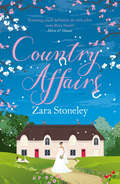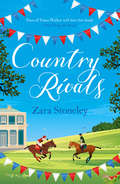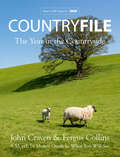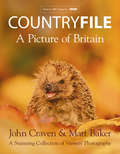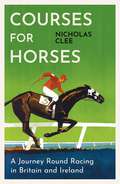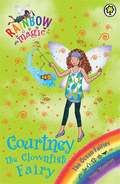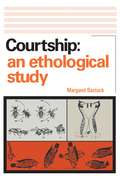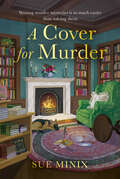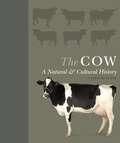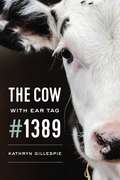- Table View
- List View
Country Affairs (The Tippermere Series)
by Zara Stoneley‘Eventing could definitely do with a few more Rory Steels!’ – Horse & Hound 'A great treat for readers…jam-packed with sexy men and horses' Bestselling author Fiona Walker Welcome to Tippermere for the wedding of the year…
Country Rivals (The Tippermere Series)
by Zara StoneleyA hilarious, sexy rom com for fans of Jilly Cooper and Fiona Walker!
The Country Set: A Celebration Of Our Best-loved Wildlife (Hannah Dale's Animals Ser. #1)
by Hannah DaleCountryfile: My Life on the Land
by Adam HensonIn 2001, Adam Henson was chosen from 3,500 applicants to become a presenter on Countryfile. Adam's agricultural knowledge and open manner soon made him a popular figure and when the programme moved to its current Sunday evening slot in 2009, he began to present a weekly report from his own farm in the Cotswolds.There, the ups and downs of the farming calendar, as told in Adam's straight-talking fashion, soon became one of the most popular parts of the programme as viewers watched him endure the stress of TB testing and his sadness at losing valuable cattle as well as the highs of spring lambing. This is the first book by Adam Henson, and it is an enthralling, first-person account of the drama, emotion and sheer hard work that is life on Adam's Farm.
Countryfile: A Year In The Countryside
by William CollinsA month-by-month celebration of the best of Countryfile magazine as well as an illustrated overview of the beauty and the drama of a year in the countryside.
Countryfile – A Picture of Britain: A Stunning Collection Of Viewers' Photography
by John Craven Matt BakerPublished In Aid of BBC Children in Need * The Countryfile Calendar has brought nature into our homes for nearly three decades, and now this comprehensive collection captures the essence of each season, bringing together viewers’ photographs of the British countryside throughout the year.
Courage Under Fire (True Blue K-9 Unit #8)
by Sharon DunnA killer in the shadows watches…and waitsThe thrilling True Blue K-9 Unit continues
Courses for Horses: A Journey Round the Racecourses of Great Britain and Ireland
by Nicholas CleeIn parks, on downlands and heaths, by motorways, overlooking firths: the racecourses of Britain and Ireland are as various as the people you meet there. Some - Newmarket, Epsom, the Curragh - are rich in history, and among the most celebrated sporting venues in the world; others - Fakenham, Bangor-on-Dee, Perth - offer more modest but no less enjoyable spectacles.Journeying round these courses, Nicholas Clee meets the people who bring them to life: from those in the spotlight, including a Grand National-winning jockey, Derby-winning owner and top TV commentator; to many others with key roles in the sport - bookmakers, form experts, racecourse managers and more. From them, he learns about the bravery, dedication, skill and expertise that make racing one of our most popular spectator sports.Whether basking in sunshine or sheltering from a hurricane, sampling a variety of pies or recoiling from the world's worst curry, losing his money with the bookies or at the Tote windows, Clee soaks up the atmosphere, delves into racing business, and marvels at the uniqueness of each course and its people. Written with a keen eye, gentle humour and a deep love for the sport, Courses for Horses take us behind the scenes at that grand outing: a day at the races.
Courtney The Clownfish Fairy (Rainbow Magic Series (PDF) #91)
by Daisy Meadows Georgie RipperRachel and Kirsty are visiting Kirsty's grandmother by the sea for their spring break. One morning they spot a very sparkly shell on the beach and it whisks them away to Fairyland! It's the occasion of the yearly Ocean Gala, where Shannon the Ocean Fairy plays her Magical Golden Conch Shell to ensure that the seas and oceans remain peaceful and ordered for the year ahead. But Jack Frost is there to ruin things for everyone! His pesky goblins break the Magical Golden Conch Shell into seven pieces as they try to steal it and the pieces are whisked away into the oceans of the human world. Queen Titania uses her magic to send seven magical sea creatures to guard the pieces of the shell, but the Ocean Fairies, and Rachel and Kirsty must get the pieces back before chaos takes over the oceans! Can they outwit Jack Frost and his goblins and make the oceans a safe and happy place for everyone once again...? In this final story in the series, Kirsty, Rachel and Courtney must find the final piece of the Magical Golden Conch Shell and return it to Shannon so that the oceans can be peaceful and harmonious once again!
Courtship: An Ethological Study
by Margaret BastockThis concise but thorough study of courtship behavior in fish, birds, and arthropods is the first rigorous examination of the evolutionary origins and mechanisms of courtship and its contribution to biological success. Demonstrating the fruitfulness of an empirically based, inductive approach to understanding courtship, the book also explains clearly how principles of modern evolutionary theory can be successfully employed in studying behavior.The author describes many observations and experiments that have not previously appeared outside specialized journals and brings an abundance of simple yet accurate examples of animal behavior to bear on explanations of ethological concepts and evolutionary theory. No attempt is made to skim over the gaps of knowledge apparent in the study of behavior evolution; rather, the author discusses the limitations and difficulties of different approaches, critically reviews the deductions that can be and have been made from them, and tries to present enough evidence on controversial points for the reader himself to judge the validity of specific arguments.Indicating how ethological method, firmly based on biological principles, can intensively investigate and illuminate a single area of animal behavior, the book will be valuable to students and professionals in zoology, animal behavior, and experimental psychology.
Courtship: An Ethological Study
by Margaret BastockThis concise but thorough study of courtship behavior in fish, birds, and arthropods is the first rigorous examination of the evolutionary origins and mechanisms of courtship and its contribution to biological success. Demonstrating the fruitfulness of an empirically based, inductive approach to understanding courtship, the book also explains clearly how principles of modern evolutionary theory can be successfully employed in studying behavior.The author describes many observations and experiments that have not previously appeared outside specialized journals and brings an abundance of simple yet accurate examples of animal behavior to bear on explanations of ethological concepts and evolutionary theory. No attempt is made to skim over the gaps of knowledge apparent in the study of behavior evolution; rather, the author discusses the limitations and difficulties of different approaches, critically reviews the deductions that can be and have been made from them, and tries to present enough evidence on controversial points for the reader himself to judge the validity of specific arguments.Indicating how ethological method, firmly based on biological principles, can intensively investigate and illuminate a single area of animal behavior, the book will be valuable to students and professionals in zoology, animal behavior, and experimental psychology.
Courtship and Mate-finding in Insects: A Comparative Approach
by Raymond J CannonThis book explores mate-finding and courtship behaviour in the insect world, in all its subtlety and diversity. Insects engage in courtship as much, or as little, as any other animal; they have songs and dances, and all manner of instruments and ornaments to attract and court the opposite sex. Insects have evolved complex chemical and acoustic communication systems, sending fragrant messages, visual signals and subtle vibrations to attract and persuade. Insects also have many different ways and means of choosing or rejecting mating partners. This beautifully illustrated book shows the incredible variety of courtship behaviours and celebrates the wonderful natural history of a wide range of insects. Varieties of courtship can occur before, during and even after copulation, and numerous examples of the different mating strategies used are presented. As well as being fascinating and entertaining, studying courtship is also useful. For example, a knowledge of the courtship and mating behaviour of important pests helps researchers understand the dynamics of mate choice and sexual selection. Knowing which behaviours are directly related with mating success can be used to improve behaviour-based control strategies and improve sterile insect techniques. Knowledge of sex pheromones, and mating behaviour, can be combined to manage insect pests by mass or mating disruption. By studying model species - such as the fruit fly, Drosophila melanogaster - researchers have discovered how genes control and influence courtship behaviour, via proteins, biochemical pathways and neural circuits. This book integrates these diverse fields into a framework constructed around courtship and mate-finding, bringing together studies from the laboratory and the field. This landmark volume will be of interest to students of biology, entomologists, naturalists and anyone with a desire to know more about the love lives of the small creatures with which we share the planet.
Courtship and Mating in Butterflies
by Raymond J CannonThis book presents a readable account of butterfly behaviour, based on field observations, great photographs and the latest research. The main focus is on courtship and mating - including perching, searching and territorial behaviour - but to understand these subjects it is necessary to explain how mates are chosen and this requires sections on wing colours and patterns. A chapter on butterfly vision is also essential in terms of how butterflies see the world and each other. There have been exciting discoveries in all of these fields in recent years, including: butterfly vision (butterfly photoreceptors), wing patterns (molecular biology), wing colouration (structural colours and nano-architecture), mating strategies and female choice (ecology and behaviour).
A Cover for Murder (The Bookstore Mystery Series)
by Sue MinixShe loved writing the perfect murder mystery, but she never wanted to be written into one . . .
The Cow: A Natural and Cultural History
by Professor Catrin RutlandA richly illustrated introduction to the science and history of the cowWe populate the countryside with cows the world over, and their familiar presence ensures that global demands for milk and beef are met. But with more than a billion cattle on the planet, the importance of cows extends well beyond food production. Cows are venerated by some religions and shunned by others; they provide leather for shoes, clothing, and other uses; and they have long been central to the agricultural way of life, working the fields, pulling carts, and providing fertilizer. The Cow is a comprehensive guide to help us understand these important animals, offering a wealth of information about their anatomy and behaviors, breed varieties, and place in human culture past and present. Exploring the cow’s livestock credentials and beyond, this book combines engaging and informative text, beautiful photographs, and explanatory diagrams to examine the cow's fascinating biology, its hard-wired behaviors, and its relationship with humankind.Provides an in-depth look at the evolution of the cow, its role in agriculture, and the development of breedsIncludes chapters on Anatomy & Biology, Society & Behavior, and Cattle & PeopleFeatures a photographic directory of forty global cattle breeds
Cow Care in Hindu Animal Ethics (The Palgrave Macmillan Animal Ethics Series)
by Kenneth R. ValpeyThis open access book provides both a broad perspective and a focused examination of cow care as a subject of widespread ethical concern in India, and increasingly in other parts of the world. In the face of what has persisted as a highly charged political issue over cow protection in India, intellectual space must be made to bring the wealth of Indian traditional ethical discourse to bear on the realities of current human-animal relationships, particularly those of humans with cows. Dharma, yoga, and bhakti paradigms serve as starting points for bringing Hindu—particularly Vaishnava Hindu—animal ethics into conversation with contemporary Western animal ethics. The author argues that a culture of bhakti—the inclusive, empathetic practice of spirituality centered in Krishna as the beloved cowherd of Vraja—can complement recently developed ethics-of-care thinking to create a solid basis for sustaining all kinds of cow care communities.
Cow (Large Print)
In this image of a cow, its head is on the left of the page and tail on the right. There is a locator dot shown, which will be at the top left of the page when the image is the right way up. The cow is looking towards you, so both ears, eyes and nostrils can be found. The cow has a large white body with large dark patches. The cow stands on four legs, each with a cleft hoof at the bottom. Just to the left of the two rear legs, are the cow's pink udder, with two of its four teats shown. On the top right of the image is the cow's tail with a little tuft of hair at the end.
Cow (UEB Contracted)
In this image of a cow, its head is on the left of the page and tail on the right. There is a locator dot shown, which will be at the top left of the page when the image is the right way up. The cow is looking towards you, so both ears, eyes and nostrils can be found. The cow has a large white body with large dark patches. The cow stands on four legs, each with a cleft hoof at the bottom. Just to the left of the two rear legs, are the cow's pink udder, with two of its four teats shown. On the top right of the image is the cow's tail with a little tuft of hair at the end.
Cow (UEB Uncontracted)
In this image of a cow, its head is on the left of the page and tail on the right. There is a locator dot shown, which will be at the top left of the page when the image is the right way up. The cow is looking towards you, so both ears, eyes and nostrils can be found. The cow has a large white body with large dark patches. The cow stands on four legs, each with a cleft hoof at the bottom. Just to the left of the two rear legs, are the cow's pink udder, with two of its four teats shown. On the top right of the image is the cow's tail with a little tuft of hair at the end.
The Cow with Ear Tag #1389
by Kathryn GillespieTo translate the journey from a living cow to a glass of milk into tangible terms, Kathryn Gillespie set out to follow the moments in the life cycles of individual animals—animals like the cow with ear tag #1389. She explores how the seemingly benign practice of raising animals for milk is just one link in a chain that affects livestock across the agricultural spectrum. Gillespie takes readers to farms, auction yards, slaughterhouses, and even rendering plants to show how living cows become food. The result is an empathetic look at cows and our relationship with them, one that makes both their lives and their suffering real.
The Cow with Ear Tag #1389
by Kathryn GillespieTo translate the journey from a living cow to a glass of milk into tangible terms, Kathryn Gillespie set out to follow the moments in the life cycles of individual animals—animals like the cow with ear tag #1389. She explores how the seemingly benign practice of raising animals for milk is just one link in a chain that affects livestock across the agricultural spectrum. Gillespie takes readers to farms, auction yards, slaughterhouses, and even rendering plants to show how living cows become food. The result is an empathetic look at cows and our relationship with them, one that makes both their lives and their suffering real.
The Cow with Ear Tag #1389
by Kathryn GillespieTo translate the journey from a living cow to a glass of milk into tangible terms, Kathryn Gillespie set out to follow the moments in the life cycles of individual animals—animals like the cow with ear tag #1389. She explores how the seemingly benign practice of raising animals for milk is just one link in a chain that affects livestock across the agricultural spectrum. Gillespie takes readers to farms, auction yards, slaughterhouses, and even rendering plants to show how living cows become food. The result is an empathetic look at cows and our relationship with them, one that makes both their lives and their suffering real.
The Cow with Ear Tag #1389
by Kathryn GillespieTo translate the journey from a living cow to a glass of milk into tangible terms, Kathryn Gillespie set out to follow the moments in the life cycles of individual animals—animals like the cow with ear tag #1389. She explores how the seemingly benign practice of raising animals for milk is just one link in a chain that affects livestock across the agricultural spectrum. Gillespie takes readers to farms, auction yards, slaughterhouses, and even rendering plants to show how living cows become food. The result is an empathetic look at cows and our relationship with them, one that makes both their lives and their suffering real.
The Cow with Ear Tag #1389
by Kathryn GillespieTo translate the journey from a living cow to a glass of milk into tangible terms, Kathryn Gillespie set out to follow the moments in the life cycles of individual animals—animals like the cow with ear tag #1389. She explores how the seemingly benign practice of raising animals for milk is just one link in a chain that affects livestock across the agricultural spectrum. Gillespie takes readers to farms, auction yards, slaughterhouses, and even rendering plants to show how living cows become food. The result is an empathetic look at cows and our relationship with them, one that makes both their lives and their suffering real.
The Cow with Ear Tag #1389
by Kathryn GillespieTo translate the journey from a living cow to a glass of milk into tangible terms, Kathryn Gillespie set out to follow the moments in the life cycles of individual animals—animals like the cow with ear tag #1389. She explores how the seemingly benign practice of raising animals for milk is just one link in a chain that affects livestock across the agricultural spectrum. Gillespie takes readers to farms, auction yards, slaughterhouses, and even rendering plants to show how living cows become food. The result is an empathetic look at cows and our relationship with them, one that makes both their lives and their suffering real.
